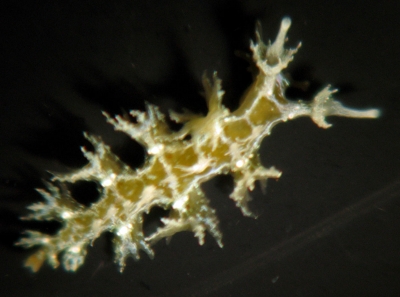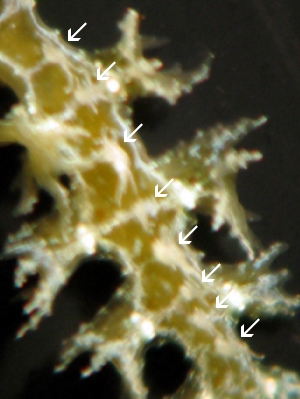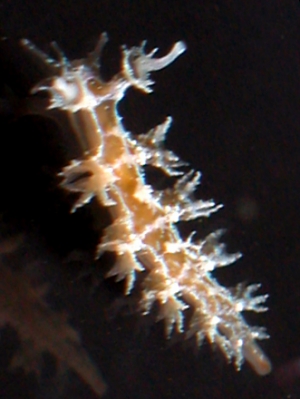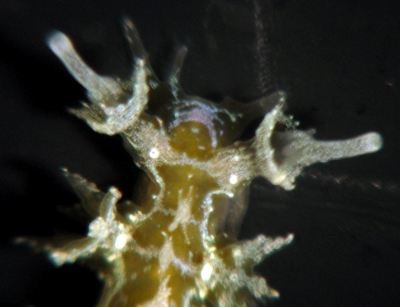Hancockia burni? at Woody Point Queensland [1]
November 13, 2008
From: David Mullins

Concerning message #3424:
Dear Bill,
I recently had the very good fortune to find the spectacular looking Hancockia burni here at Woody Point feeding on hydroids growing on the thalli of Dictyopteris sp. brown algae in the intertidal gutters.
The compound cerata are intriguing in appearance being held up like a cupped hand and carried high when on the move (might this be a defensive posture?) but spread out like finger tips balancing on a table when at rest.
Down the centreline of the dorsal surface is a line of feathery compound papillae. The rhinophoral sheath is cup shaped at its distal end and fringed with a number of papillae. A flattened lobe having finger like projections can be seen each side of the mouth with the right side on this specimen appearing to be damaged or poorly developed.
Locality: Woody Point, Redcliffe Peninsula, Moreton Bay, intertidal, Queensland, Australia., Pacific Ocean, 09 August 2008, weed covered intertidal rocks. Length: 7 mm. Photographer: David Mullins.
More pictures of specific features follow in a second message [#22027 ].
Kind regards,
David Mullins
marineimages@hotmail.com



Dear David,
Thanks for these photos of a very interesting animal. Apart from the usual curious structures found in Hancockia, in particular the hand-like 'cerata', I am intrigued by the row of distinct branched papillae - which I guess we can call gills - which form a row down the dorsal midline. I don't recall any description of such gills in this genus before, but on looking at my fieldnotes on Hancockia sp. 1 from New Caledonia, I note a row of tubercles down the midline, which could well be these branched papillae retracted.
Now to the vexed question of whether these are Hancockia burni. Thompson (1972) described that species from six 10 m long specimens he collected from Nth Stradbroke Island, sthn Queensland. So in terms of geographic locality, your animals match. Unfortunately when we look at the anatomical detail I can't find any characters which would not apply to any member of the genus. More importantly the description of the colour of the living animal is brief, but certainly doesn't fit your animals.
"The body-color was translucent white with a fine irregular pattern of reticulate brown markings and opaque white specks, giving a marbled appearance. A small minority of the white specks has a green iridescent sheen."
The distinctive opaque white pattern of lines, and the midline row of gills, are not mentioned. I wondered if the lack of colour in Thompson's animals was a result of smaller size, but his animals were if anything, slightly larger than yours. It's possible that there is one species with a very variable colour pattern, but so far we have no evidence for that. I suspect your animal is what I am calling Hancockia sp. 1. Perhaps it will prove to be a colour form of Hancockia burni, but up to now I know of no finds of animals which match Thompson's H. burni in colour.
Best wishes,
Bill Rudman
Related messages
-
Hancockia burni ? at Woody Point Queensland [2]
From: David Mullins, November 13, 2008 -
Hancockia from Izu, Japan
From: Haruo Kinoshita, January 25, 2001
